Intel Core i9-10850K Review: The Real Intel Flagship
by Dr. Ian Cutress on January 4, 2021 9:00 AM EST- Posted in
- CPUs
- Intel
- Core
- Z490
- 10th Gen Core
- Comet Lake
- LGA1200
- i9-10850K
Gaming Tests: Far Cry 5
The fifth title in Ubisoft's Far Cry series lands us right into the unwelcoming arms of an armed militant cult in Montana, one of the many middles-of-nowhere in the United States. With a charismatic and enigmatic adversary, gorgeous landscapes of the northwestern American flavor, and lots of violence, it is classic Far Cry fare. Graphically intensive in an open-world environment, the game mixes in action and exploration with a lot of configurability.
Unfortunately, the game doesn’t like us changing the resolution in the results file when using certain monitors, resorting to 1080p but keeping the quality settings. But resolution scaling does work, so we decided to fix the resolution at 1080p and use a variety of different scaling factors to give the following:
- 720p Low, 1440p Low, 4K Low, 1440p Max.
Far Cry 5 outputs a results file here, but that the file is a HTML file, which showcases a graph of the FPS detected. At no point in the HTML file does it contain the frame times for each frame, but it does show the frames per second, as a value once per second in the graph. The graph in HTML form is a series of (x,y) co-ordinates scaled to the min/max of the graph, rather than the raw (second, FPS) data, and so using regex I carefully tease out the values of the graph, convert them into a (second, FPS) format, and take our values of averages and percentiles that way.
If anyone from Ubisoft wants to chat about building a benchmark platform that would not only help me but also every other member of the tech press build our benchmark testing platform to help our readers decide what is the best hardware to use on your games, please reach out to ian@anandtech.com. Some of the suggestions I want to give you will take less than half a day and it’s easily free advertising to use the benchmark over the next couple of years (or more).
As with the other gaming tests, we run each resolution/setting combination for a minimum of 10 minutes and take the relevant frame data for averages and percentiles.
| AnandTech | Low Resolution Low Quality |
Medium Resolution Low Quality |
High Resolution Low Quality |
Medium Resolution Max Quality |
| Average FPS | 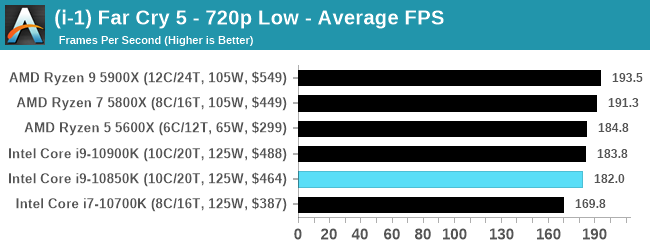 |
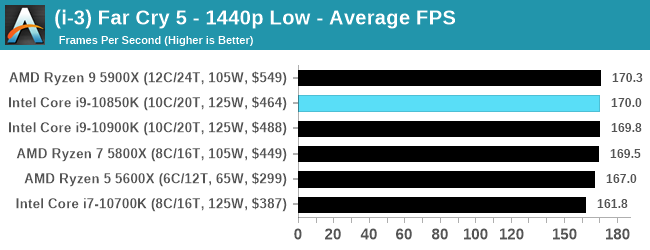 |
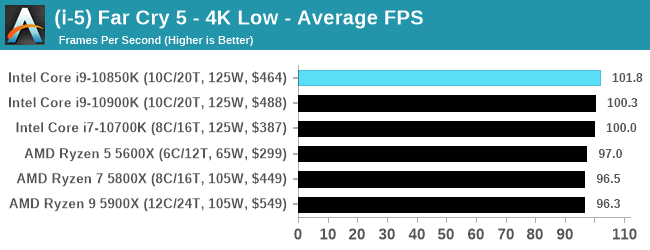 |
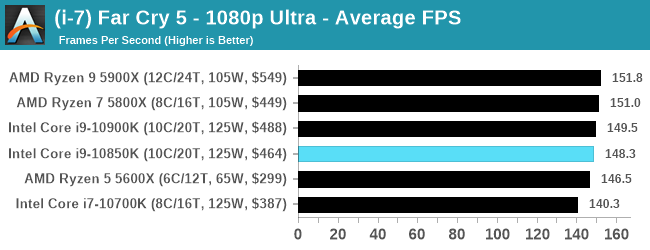 |
| 95th Percentile | 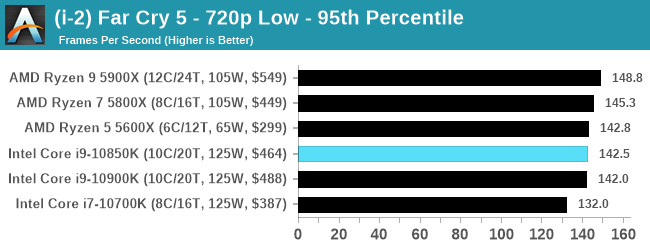 |
 |
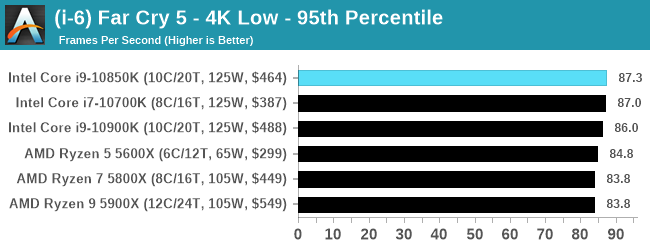 |
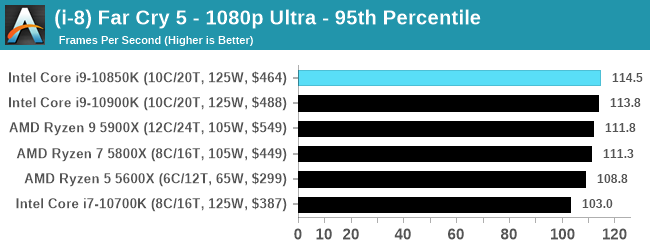 |
All of our benchmark results can also be found in our benchmark engine, Bench.


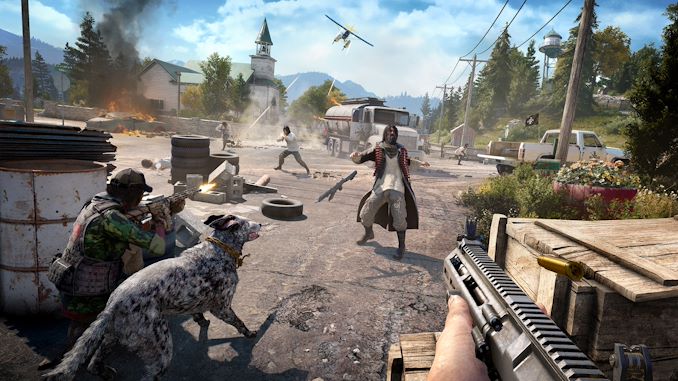









126 Comments
View All Comments
Otritus - Monday, January 4, 2021 - link
Furthermore, Intel already uses a 1+4 design in their Lakefield processors. So, 1+n designs are possible on x86.It's 2021, when will Anandtech get an edit button.
phoenix_rizzen - Monday, January 4, 2021 - link
What all these graphs show me is that AMD's Zen 3 CPU architecture is a heck of a lot better than Intel's 10th Gen Comet Lake CPU architecture.The 8-core 5800X is within spitting distance of the 10-core 10850K is many benchmarks, and way ahead of it in many others. You pay less upfront, you pay less in power/cooling, and you get better/same performance! Even in multi-threaded benchmarks where the AMD CPU has two fewer cores, but better overall performance.
Hopefully Intel get's their Tiger Lake desktop CPUs (or whatever Lake naming variation the 11th Gen stuff will be) sorted out soon. The only thing holding AMD back right now is supply issues (and a lack of support from the big OEMs like HP, Dell, Compaq, etc).
2021 will be an interesting time for those upgrading desktops... :)
Deicidium369 - Monday, January 4, 2021 - link
"Hopefully Intel get's their Tiger Lake desktop CPUs (or whatever Lake naming variation the 11th Gen stuff will be) sorted out soon" Rocket Lake 11900K is the top SKU and wrecks the 5800X"The only thing holding AMD back right now is supply issues (and a lack of support from the big OEMs like HP, Dell, Compaq, etc)" Compaq? really? You know that Compaq was bought by HP... Maybe Lenovo would have been a better choice there...
Intel provides designs for OEMs - have been doing this since the ultralight era - Intel makes it easy for OEMs to introduce a design using Intel SOCs. AMD does not do this - which is AMD's failing - the OEMs have to spend their own money designing a platform for AMD - and at some point hopefully recoup their investment - the sales volume for AMD is low enough that it often doesn't.
Chicken and Egg - OEMs won't introduce high end AMD designs due to cost, consumers won't be able to purchase a high end AMD - and will instead purchase an Intel.
IF AMD started providing designs and packages of components (like the 1W display for Ice Lake and Tiger Lake 13") to the OEMs - then AMD can start to expect higher end designs, rather than some 15" chassis from 3 years ago - by relieving the OEMs from spending $$ to engineer AMD designs, AMD would remove that burden, and also somewhat dictate what tier these designs go into ... provide the same design to all OEMs (just like Intel does)
This is not bashing AMD - they are missing several tricks to get their product in the high end laptop sector... it's not bribing or anything else - it is SMART BUSINESS.
IF AMD wants it's SOCs in high end designs like the Dell XPS - then it's not difficult to see the path forward.
JayNor - Monday, January 4, 2021 - link
TGL added integrated pcie4, Thunderbolt 4, Wifi6 and lpddr5, and already has avx512, dlboost... all in a laptop chip. When will the competition have those features?RSAUser - Tuesday, January 5, 2021 - link
Interesting that I've seen quite a few high end AMD OEM systems, they can just reuse the design of the Intel counterpart, change is just the mobo and CPU, which doesn't influence Form factor much since can get mobo with same Form factor.powerarmour - Tuesday, January 5, 2021 - link
Just wait until you see the power consumption numbers for Rocket Lake then, you'll then see who wrecks what.Makaveli - Monday, January 4, 2021 - link
Where did you see a 11900k which is unreleased at the moment wrecking a 5800x? Those leaked geekbench scores lol? Citation needed.AndrewJacksonZA - Monday, January 4, 2021 - link
So let me get this straight: A CPU with 65% more cores, 100% more power consumed, and with a 50% greater price than their competitor's smallest and cheapest CPU, is being outperformed or equalled by that little CPU.OK, right on.
JayNor - Monday, January 4, 2021 - link
"Intel likes to point out it has another 24 PCIe 3.0 lanes through the chipset, however this is limited by the DMI/PCIe 3.0 x4 uplink to the processor."Ok, through a switch, but perhaps the OEMs would have to add a switch on the motherboard if Intel only provided four lanes. Seems like a reasonable feature.
Hulk - Monday, January 4, 2021 - link
I loved the article. Well-written, very informative, and entertaining. Also little is ever written when it comes to binning. It's great to hear Ian's thoughts on this and the lengths Intel has been going to in order to stay competitive.Ian presented the facts of the case. We are the jury and make our own decisions.